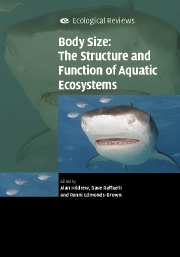Book contents
- Frontmatter
- Contents
- List of contributors
- Preface
- 1 The metabolic theory of ecology and the role of body size in marine and freshwater ecosystems
- 2 Body size and suspension feeding
- 3 Life histories and body size
- 4 Relationship between biomass turnover and body size for stream communities
- 5 Body size in streams: macroinvertebrate community size composition along natural and human-induced environmental gradients
- 6 Body size and predatory interactions in freshwaters: scaling from individuals to communities
- 7 Body size and trophic cascades in lakes
- 8 Body size and scale invariance: multifractals in invertebrate communities
- 9 Body size and biogeography
- 10 By wind, wings or water: body size, dispersal and range size in aquatic invertebrates
- 11 Body size and diversity in marine systems
- 12 Interplay between individual growth and population feedbacks shapes body-size distributions
- 13 The consequences of body size in model microbial ecosystems
- 14 Body size, exploitation and conservation of marine organisms
- 15 How body size mediates the role of animals in nutrient cycling in aquatic ecosystems
- 16 Body sizes in food chains of animal predators and parasites
- 17 Body size in aquatic ecology: important, but not the whole story
- Index
- References
7 - Body size and trophic cascades in lakes
Published online by Cambridge University Press: 02 December 2009
- Frontmatter
- Contents
- List of contributors
- Preface
- 1 The metabolic theory of ecology and the role of body size in marine and freshwater ecosystems
- 2 Body size and suspension feeding
- 3 Life histories and body size
- 4 Relationship between biomass turnover and body size for stream communities
- 5 Body size in streams: macroinvertebrate community size composition along natural and human-induced environmental gradients
- 6 Body size and predatory interactions in freshwaters: scaling from individuals to communities
- 7 Body size and trophic cascades in lakes
- 8 Body size and scale invariance: multifractals in invertebrate communities
- 9 Body size and biogeography
- 10 By wind, wings or water: body size, dispersal and range size in aquatic invertebrates
- 11 Body size and diversity in marine systems
- 12 Interplay between individual growth and population feedbacks shapes body-size distributions
- 13 The consequences of body size in model microbial ecosystems
- 14 Body size, exploitation and conservation of marine organisms
- 15 How body size mediates the role of animals in nutrient cycling in aquatic ecosystems
- 16 Body sizes in food chains of animal predators and parasites
- 17 Body size in aquatic ecology: important, but not the whole story
- Index
- References
Summary
Introduction
Since its first appearance (Hairston, Smith & Slobodkin, 1960), the hypothesis that predation can structure communities has courted controversy (Shapiro, Lamarra & Lynch, 1975; Strong, 1992; McCann, Hastings & Strong, 1998). Nearly 50 years later there is still ongoing debate over the importance of predation relative to other factors limiting the growth of populations (Pace et al., 1999; Holt, 2000; Polis et al., 2000; Power, 2000), and the conditions that cause the effect of predation to cascade through the community (Polis & Strong, 1996; Schmitz, Krivan & Ovadia, 2004; Borer et al., 2005; Vander Zanden, Essington & Vadeboncoeur, 2005). With the discovery of predator impacts on the structure and dynamics of a diversity of real communities (Paine, 1980; Power, Matthews & Stewart, 1985; Carpenter & Kitchell, 1993), it became apparent that higher trophic levels could affect the biomass and dynamics of not only their prey, but of their prey's prey and, hence, the whole community. Earlier it was assumed that communities were typically pyramidal in structure, with declining biomass in each successive trophic level, and the dynamics of each trophic level dependent upon those of their prey and ultimately the primary producers/basal resources (Whittaker, 1961). It is now clear from habitats as diverse as Californian islands (Roemer, Donlan & Courchamp, 2002), the forests of Yellowstone Park (Ripple & Beschta, 2004) and the cod banks of the North Atlantic (Worm & Myers, 2003; Frank et al. 2005) that this assumption is not correct, such that nowadays the predictions of the trophic cascade influence how we manage our natural environment (Scheffer, 1998).
- Type
- Chapter
- Information
- Body Size: The Structure and Function of Aquatic Ecosystems , pp. 118 - 139Publisher: Cambridge University PressPrint publication year: 2007
References
- 10
- Cited by



